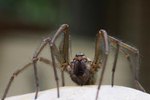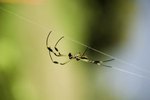
It’s easy to be alarmed at the sight of a fast-moving centipede racing across your floor, but you have little to fear from these multi-legged arthropods. According to Utah State University, it’s unusual for a human to be bitten by a centipede and highly unusual for such a bite to do any lasting harm. Centipedes actually do more good than harm, due to their predatory natures.
General Appearance
While centipedes typically don’t get longer than about 2 inches, in areas where there’s plenty of warmth and moisture they may reach up to 12 inches in length. They have flattened bodies made up of a series of segments, with rounded heads capped by two long antennae. On close inspection it becomes obvious that the antennae are made up of a series of tiny segments, larger next to the creature's head and gradually getting smaller toward the end. Centipedes are generally brown, reddish-brown or gray, though color varies by species.
Legs
Centipedes have one pair of legs per body segment. The pair directly behind the head is specialized and serve as fangs the centipede uses to bite its prey. The last pair of legs is also specialized and is longer than the rest, allowing the centipede to catch and hold its prey while it injects venom. The centipede’s legs stick out from its body on both sides, making it easy to distinguish from the millipede, which has all its legs underneath it.
Food
Even if most people don’t welcome centipedes into their homes, this arthropod is beneficial because it eats many of the pests that might otherwise cause damage to the house or its contents. Centipedes use their venom to paralyze prey such as insects and spiders. If a large number of centipedes are observed in one area, such as your home or garden, chances are that they are there because of an abundance of prey. Eliminating the prey will decrease the centipede population.
Habitat
Centipedes live in damp, sheltered places such as under rocks and logs or in the cracks along walls or foundations. They cannot survive where it is dry and may move into damp basements, hiding under boxes on concrete floors or in cracks between the slabs. Centipedes will also take shelter in kitchens and bathrooms to take advantage of the moisture there. They are mostly nocturnal and rarely seen in the daytime, though they may sometimes venture out to hunt while the sun is still up.
References
Photo Credits
-
Jupiterimages/Photos.com/Getty Images



